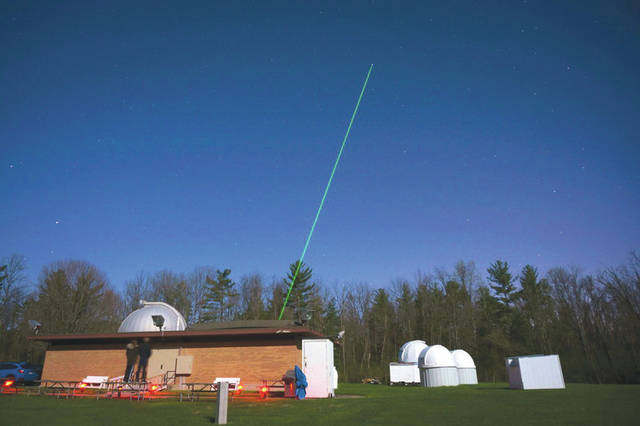YELLOW SPRINGS — A research project intended to enable more precise imaging of space objects has moved from lab bench testing to field testing at the John Bryan State Park observatory, illuminating night skies with a green laser beam of light.
The project is a collaboration between the Electro-Optical Space Situational Awareness Team of the Air Force Research Laboratory’s Sensors Directorate and the Air Force Institute of Technology’s Department of Engineering Physics.
Inside a seemingly nondescript facility enclosed by a chain link fence with a locked gate at the end of a narrow gravel road leading through the forest sits a unique telescope that has been retrofitted with a laser and sensors designed to probe turbulence in the atmosphere. The roof above the telescope opens and provides a clear view of a starlit sky as the telescope is moved into position according to coordinates programmed by scientists and engineers.
“The Turbulence and Aerosol Research Dynamic Interrogation System, or TARDIS, is an easily seen pulsed green laser used for atmospheric research,” said Steven Zuraski, principal investigator on the project. “The green light goes up, scatters off of molecules and dust particles in the atmosphere, and the reflected light comes back down and is measured by the sensor system. This measurement can quantify the optical turbulence structure or blurriness of the atmosphere.”
Analyzing these measurements will provide scientists with valuable information when imaging objects in space.
“In order to collect enough light scattering off that dust, you need a relatively big telescope, so we’ve selected the 24-inch telescope at the John Bryan Observatory,” said 2nd Lt. Charles Carr, an astrophysicist with the research team. “Not all the light is going to reflect back to the telescope. The majority transmits out through the atmosphere or scatters off in different directions. This is why it can be seen by observers looking into the night sky at John Bryan State Park. We’re trying to measure pretty small amounts of light that actually scatter back from different levels in the atmosphere.”
“You can think of it like looking at a star. Turbulence is what causes the star to twinkle, so we are measuring the amount of twinkle in the stars. This helps us understand how to remove the cause of the twinkle and obtain clearer images of space objects,” Zuraski said.
Turbulence in the atmosphere is caused by mixing of air at different temperatures, pressures and densities, Carr explained.
The observatory, owned by the State of Ohio, is under a joint lease with the Miami Valley Astronomical Society, or MVAS – a group of local astronomers, and Applied Optimization, a local small business supporting AFRL’s efforts on the research project. The facility was built by the Air Force in the 1960s, when it was in operation as a satellite tracking facility. In fact, the facility has multiple telescopes, with the Air Force project occupying one side of the facility and the MVAS the other.
The facility is great for observation because of the dark skies available at the park.
The laser has been propagating into the atmosphere since April 12, a date the team refers to as “first light.” Prior to first light, the laser had been tested in a laboratory environment for two years.
Light leaves the laser, travels through an optical beam routing and reshaping system, then goes out into the atmosphere. The returned scattered light is collected by the telescope and is measured by the sensor system.
“Without turbulence, the returned wave front would be perfectly flat as seen by the telescope; with turbulence, it will look like a complex wavy surface and we have a sensor that measures that,” Zuraski said. “That sensor has a really small field of view so there are lot of challenges with getting this light beam to shine correctly onto it. Alignment tasks are always very time consuming in optical systems.”
Safety procedures have been built into all stages of operation to avoid disruption to any airborne object, including those in orbit.
“We chose green for the laser specifically because it scatters off the molecules and dust in the atmosphere really well at the propagation distances we are interested in researching,” he said.
The research helps the SSA Team paint a clearer picture of space, but this research isn’t the team’s first project studying imaging through turbulence.
“On average, the atmosphere changes about 25 to 35 times per second,” Guliano said. “Conditions such as wind, humidity, and general movement in the atmosphere cause changes on that level. The idea is that if you take images at a high enough frequency, you can get multiple images of a static atmosphere. If it’s changing at 25 times per second and you’re taking images at 200 times per second that means you’ll get eight images per frozen atmosphere. The idea is that we can control what portion of the atmosphere is measured from the returning laser light.”






